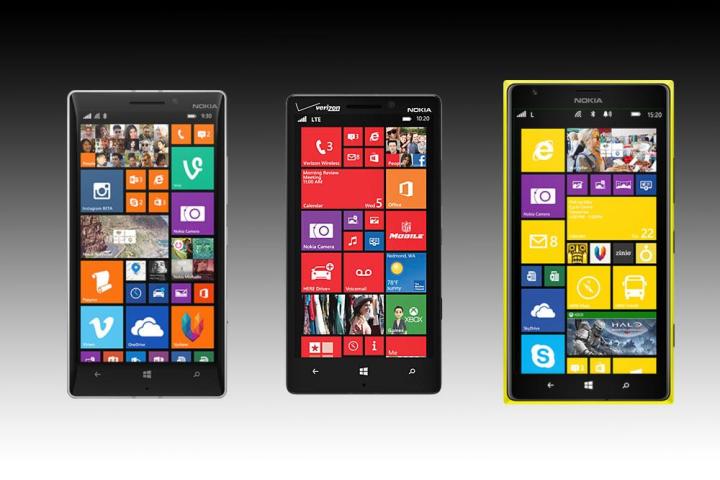
Additionally, take a look at our side-by-side comparison of the Lumia 930, Galaxy S5, and the iPhone 5S for a closer look at the competition.
|
Nokia Lumia 930  |
Nokia Lumia Icon |
Nokia Lumia 1520 |
|
| Size | 137 x 71 x 9.8 (mm) | 137 x 71 x 9.8 (mm) | 162.8 x 85.4 x 8.7 (mm) |
| Weight | 167 grams | 167 grams | 209 grams |
| Screen | 5-inch OLED | 5-inch OLED | 6-inch IPS LCD |
| Resolution | 1920 x 1080 pixels | 1920 x 1080 pixels | 1920 x 1080 pixels |
| OS | Windows Phone 8.1 | Windows Phone 8.0 | Windows Phone 8.1 |
| Storage | 32 GB | 32 GB | 32 GB |
| SD Card Slot | No | No | Yes, MicroSD |
| Processor | Qualcomm Snapdragon 800 | Qualcomm Snapdragon 800 | Qualcomm Snapdragon 800 |
| RAM | 2 GB | 2 GB | 2 GB |
| Connectivity | Wi-Fi, 4G LTE, NFC | Wi-Fi, 4G LTE, NFC | Wi-Fi, 4G LTE, NFC |
| Camera | Front 1280 x 960, Rear 20 MP | Front 1280 x 960, Rear 20 MP | Front 1280 x 960, Rear 20 MP |
| Bluetooth | Yes, Version 4.0 | Yes, Version 4.0 | Yes, Version 4.0 |
| Motion Processor | Sensor Core | No | No |
| Fingerprint sensor | No | No | No |
| Water Resistant | No | No | No |
| Battery | 2420 mAh | 2420 mAh | 3400 mAh |
| Charger | Qi Wireless | Qi Wireless | Qi Wireless |
| Marketplace | Windows Phone Apps | Windows Phone Apps | Windows Phone Apps |
| Ave. Price | $599.00 | $199.99 | $549.00 |
| Availability | June in European markets | Verizon Wireless Only | AT&T |
| DT Review | Coming soon | 3.5 out of 5 | 3.5 out of 5 |
Power and Productivity
All three Lumia phones are outfitted with Qualcomm Snapdragon 800 processors. The 800 has become a standard chip for newer mobile phones due to its power efficiency, solid performance and speed, and the decent feature set it provides. At 2.2GHz across four cores, users will have little trouble running the latest and greatest in Windows Phone apps. All three phones feature a sufficient 2 GB of RAM, 4G LTE, NFC, and Wi-Fi, offering standard connectivity featured on most mobile devices. Out of the three, the only phone that has expandable memory is the 1520, with a MicroSD slot supporting up to 64GB of additional storage. For the Icon and 930, users will have to settle for the 32GB of internal storage. Additionally, the Lumia 930 touts the aforementioned Sensor Core for lower-power motion sensing when used in conjunction with Bing Health and Fitness, among other utilities. Neither the Icon or 1520 feature a motion processor of any kind.
Design
While all the displays run at a native 1920 x 1080 pixels, the 1520 adds an extra inch of real estate, while switching from OLED to IPS LCD technology. All three phones also feature a slightly curved back panel, rendering them more comfortable to hold as well as preventing the speaker from being muffled when the devices rests on a flat surface. All three phones bear the unmistakable, brightly-colored palette of the Lumia line, though the 930 has a new bright-green design. Moreover, Qi Wireless compatibility makes charging wireless and easy, and users can charge all three Lumia phones via the Nokia Fatboy pillow.
Camera
Again, we see the striking similarities between the camera sensors adorning all three devices. Each boasts a 20-megapixel sensor built into the rear, and Nokia does an excellent job of equipping the sensors with high-quality optics and solid software. The front sensor captures 1280 x 960 pixel resolution images, meaning it’s on the tail-end of smartphone cameras and really only good for checking to make sure your hair looks okay and the occasional video chat check-in. However, none of the phones will disappoint if Instagram and Facebook are your only image outputs, and though it depends on the model, they may even hold up against a standard point-and-shoot camera.
Conclusion
All three of these Lumia phones are remarkably similar, with differences in availability and screen size being major deciding factors. The 1520 has a slightly larger screen and the option for expandable storage, but the larger size may not be what some users are looking for, since it’s a good deal larger than most smartphones. If the Icon or 930 seem more in tune with your style, the choice is basically dictated by your carrier. The Icon is currently a Verizon exclusive, while the 930 will soon launch in Europe, the Middle East, and India with a global launch following soon afterward. We expect it will come to AT&T, Sprint, and possibly T-Mobile as well.



